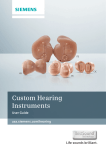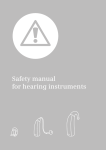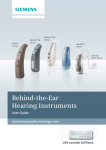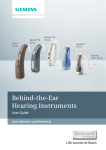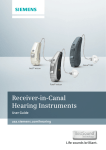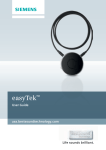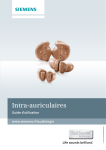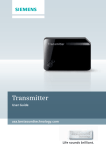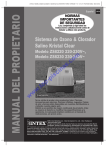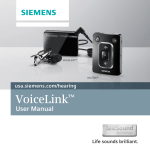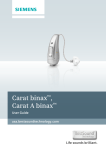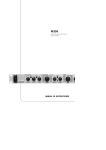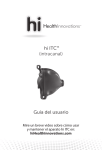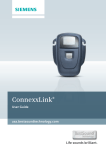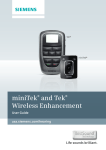Download Custom Hearing Instruments
Transcript
ITE HS CIC ITC IIC Custom Hearing Instruments User Guide usa.bestsoundtechnology.com Life sounds brilliant. Thank you for choosing our hearing instruments to accompany you through everyday life. Like anything new, it may take you a little time to become familiar with them. Enhance your Siemens experience. Learn about your hearing aids and accessories you may find helpful, access the latest information about hearing health, and receive promotional offers by joining the Siemens hearing health community at* usa.bestsoundtechnology.com/join or: Learn more about Siemens products by scanning the QR code This guide, along with support from your Hearing Care Professional, will help you understand the advantages and greater quality of life your hearing instruments offer. If this Hearing Instrument is being purchased for an infant or young child, please confirm with your Hearing Care Professional that it is recommended for this purpose and to ensure appropriate supervision and use of the product. Hearing Aid Information Serial Number: Left: Right: Battery Size: Left: Right: Purchase Date: Left: Right: *We respect your privacy. We will not sell, rent, or give your name or e-mail address to anyone. At any time, you can select a link at the bottom of every email to unsubscribe or update profile. Hearing Care Professional Info stamped here Table of Contents Getting Started Your hearing instruments Safety information Feature card Identification information Changing the battery Battery tips Turning the hearing instrument on or off Inserting and removing Inserting and removing-CIC/IIC hearing instrument 4 4 5 5 8 9 10 10 11 Operating Your Hearing Instrument – Optional Features Remote Control 13 easyTek™ and miniTek® Wireless Enhancement, and easyPocket™ Remote Control 14 Changing the volume 15 Learning volume preference feature 16 SoundLearning® feature 16 Changing the program 16 Directional microphone system 18 Telecoil18 AutoPhone®18 AutoPhone magnet accessory 19 2 Operating Your Hearing Instrument – Programmable Features Wireless functionality Wireless information Push button on/off Power on delay Low battery indicator Volume control alert tones Program change alert tones 20 22 24 24 24 24 25 Tinnitus Therapy Feature 25 Listening Tips 28 Maintenance and Care Maintenance and care Cleaning instructions for hearing instruments with integrated wax protection 29 30 Performance Checklist 31 Health Considerations 32 Important Notices 33 Warranty and Service 35 3 Getting Started Try wearing your hearing instruments and you may once again enjoy the sounds of the environment and conversation with your family and friends. Your decision to purchase hearing instruments reflects the importance you place on quality and reliability. Your custom hearing instruments are designed for comfort, performance and durability. Please read this manual carefully to benefit from all the features of your new hearing instruments. Safety Information WARNING Choking hazard posed by small parts. • Keep hearing instruments, batteries and accessories out of children’s reach. • If swallowed consult a physician or hospital immediately. • If infants, small children or mentally disabled persons need to wear hearing instruments ensure adequate supervision. WARNING Risk in explosive environments, e.g., mining areas • Don’t use your hearing instruments (and remote control) in areas where there is danger of explosions. Please read this manual carefully to benefit from all the features of your new hearing system. 4 • Risk of impairing the residual hearing of the user. Use only hearing instruments that have been fitted especially for your needs. • Risk of electrical shock caused by damaged devices. Do not use obviously damaged devices and return them to your Hearing Care Professional. • Devices may interfere with electronic equipment. Verify your devices are turned off in areas where the use of electronics or wireless devices is restricted. t Your hearing instruments WARNING Feature card Please refer to the feature card included with this manual. The feature card is located at the back of this user manual in a pocket. The feature card contains important information about the features in your new hearing instruments. This includes battery size, and features associated with the operation of your new hearing instruments. More information about these features is located in the Operation section of this manual. Identification information Your hearing instruments have a serial number engraved on them. The location of the serial number is on the outside of the hearing instrument. The year of manufacture is incorporated into the serial number. Please note the warranty is based upon the date of purchase, not the date of manufacture. 5 Because your hearing instrument is custom made, it’s appearance may vary from the ones pictured. CIC Record the serial number in the front of this manual for future reference. Your hearing instrument was custom made and its appearance may vary from the ones pictured. 2.X: facility code where instrument was manufactured Refer to the feature card for an explanation of the external controls on your hearing instrument. 3.Serial number ITE 5.Manufacturer/Distributor 6 xxxx xx 15X0123456R 1 2 3 4 Fig. 1C: CIC hearing instrument 6.Model 2.X: facility code where instrument was manufactured 3.Serial number 1 7.Wireless feature where applicible 6 4 XXXXX/XXX 15X123456R Insio™ IIC 4.L or R: left or right ear instrument 1.15: year manufactured 5.Manufacturer/Distributor 6.Model 7.Wireless feature where applicible xxxx/xx R 56 15X01234 4.L or R: left or right ear instrument 5 1.15: year manufactured 5 1.15: year manufactured 2 3 Fig. 1A: ITE hearing instrument ITC/HS 5 1.15: year manufactured 3.Serial number 6 5.Manufacturer/Distributor 6.Model 1 XXXXX XX 15X123456R 5 XXXXX 6 XXX 3456R 15X012 XXXXX XXX 15X0123456R 4.L or R: left or right ear instrument 2.X: facility code where instrument was manufactured 3.Serial number 2.X: facility code where instrument was manufactured 1 2 3 4 Fig. 1D: Insio IIC hearing instrument 4 4.L or R: left or right ear instrument 5.Manufacturer/Distributor 6.Model 7.Wireless feature where applicible 6 2 3 Fig. 1B: ITC/HS hearing instrument 7 Changing the battery “+” Sign Refer to the feature card or check with your Hearing Care Professional to determine the battery size for your hearing instrument. Before using your hearing instrument, place the battery into the battery compartment door. Using the fingernail of either your thumb or index finger, pull the tab on the battery compartment door outward until the door swings open all the way (Fig. 2). Battery "+" Sign Battery Fig. 3: Changing the battery Gently close the battery compartment door. Avoid forcing the door shut. If it does not close easily, check to see if the battery was inserted properly. Once the battery is in its proper position, your instrument is ready to operate. Battery compartment door Fig. 2: Opening the battery compartment Place the proper size battery into the battery compartment door, observing the correct polarity. The “+” sign on the battery must match the “+” sign stamped on the top of the battery compartment door (Fig. 3). Your hearing instrument may be programmed to inform you when the battery should be replaced. Refer to the low battery indicator information in the Operation section (page 20) of this manual for further information. Battery tips • If a battery is accidentally swallowed, seek medical attention immediately, or call the National Battery Hotline collect at (202) 625-3333. • Always use the recommended battery size for your hearing instrument. The battery size information for your hearing instrument is located on the feature card. • Remove the battery from your instruments when not in use. This prevents possible damage from expansion or leakage of the battery, if the instruments are not fully turned off. 8 9 • Always carry spare batteries in the event that your current battery goes dead. Place each spare battery in an individual, non-metallic container to prevent contact with other batteries or metal objects, such as keys or coins. • Follow your local recycling rules for battery disposal Turning the hearing instrument on or off To turn the hearing instrument on, insert a battery into the hearing instrument and completely close the door. To turn the hearing instrument off, open the battery door. Hearing instruments may also be programmed to allow you to turn them on and off using the program button. Refer to the Operation section (page 24) for further information. Inserting and removing WARNING Fig. 4: Inserting the hearing instrument If you have difficulty inserting the hearing instrument, try pulling the ear up and back for an easier insertion. To remove the hearing instrument, push lightly on the back of the ear to help loosen it. Then, using your index finger, carefully pull the hearing instrument from your ear. Never pull on the battery compartment door to remove the hearing instrument, as this could cause damage to your hearing instrument. Inserting and removing–CIC/IIC hearing instruments Hold the instrument between your thumb and index finger. With the face of the instrument toward the outside, place the canal portion into your ear. Gently work the instrument into its proper position by slightly twisting until it is firmly seated. Lightly press inward for a secure and comfortable fit (Fig. 4). Never pull on the battery compartment door to remove the hearing instrument, as this could cause damage to your hearing instrument. WARNING Hold the hearing instrument between your thumb and index finger. With the face of the hearing instrument toward the outside, paying special attention to the removal strand to indicate the bottom, place the hearing instrument in your ear canal. Gently work it into its proper position by slightly twisting until it is firmly seated. For CIC/IICs, the instrument should sit deep in your ear canal. Do not force it deeper than it will comfortably fit. 10 11 Operating Your Hearing Instrument – Optional Features Refer to the feature card included with this manual to determine the optional features your hearing instrument is equipped with. Optional features are listed on the left column of the feature card, see below (Fig. 6): Fig. 5: Proper location of the CIC/IIC hearing instrument The nylon strand has been provided to allow removal of the CIC/IIC hearing instrument. Firmly grasp its bead and slowly, gently pull the hearing instrument out of your ear. It often helps to push lightly on the back of your ear to loosen the instrument. Using the removal strand, the hearing instrument should pull out easily. If you experience difficulty removing the instrument and it remains lodged in your ear, contact your Hearing Care Professional immediately. IN-THE-EAR Use the type of battery shown below FEATURE CARD Program button Microphone Microphone Battery compartment door Volume control Vent Optional Features OPTIONAL FEATURES Volume control Learning volume preference Program button Directional microphone Telecoil AutoPhone® ePocket® remote control PROGRAMMABLE FEATURES e2e wireless® Push button on/off Power on delay Low battery indicator Volume control alert tones Program change alert tones Fig. 6: FEATURE CARD Optional features section circled PROGRAMS Program number CAUTION! Do not insert any item into your ear to remove the hearing instrument. Do not pull on the battery compartment door to remove the instrument, as this could cause damage to the instrument. Listening environment 1 2 3 4 Refer to the ITE User Manual for information on Optional Features and Programmable Features. Remote Control You may have received an optional remote control with your hearing instrument. They can be used to change the memory and volume of your hearing system. For further information ref er to the remote control instruction manual. 12 13 easyTek™ and miniTek® Wireless Enhancement, and easyPocket™ Remote Control You may have received the optional easyTek, miniTek, or easyPocket (Fig. 14) with your hearing instrument. miniTek or easyPocket can be used to change the program and volume of your hearing system. In addition, other adjustments can also be made to sound quality. easyTek™ To increase the volume on your right-side hearing aid, rotate the volume control wheel in a clockwise direction. To increase the volume on your left-side hearing aid, rotate the volume control wheel in a counter-clockwise direction. Micro-USB FM input Reset Volume control wheel easyPocket™ Control buttons miniTek® Program button Your hearing instrument is fully automatic. However, it may be equipped with an optional volume control for manual adjustment. To reduce the volume, rotate the volume control wheel in the opposite direction. Counter-clockwise for your right-side hearing aid and clockwise for your left-side hearing aid (Fig. 8). Volume up/down Port for audio devices Changing the volume Volume up Volume down Program change button Volume up/ down buttons Fig. 14: easyTek, miniTek, and easyPocket remote controls Fig. 8: Adjusting the volume You may hear soft beeps each time you change the volume and a three beep warning when the volume limit has been reached. These tones can be enabled or disabled by your Hearing Care Professional. You may have received an optional remote control with your hearing instrument. Press the Volume Up (+) button on the remote to increase the volume. Press the Volume Down (-) button on the remote to reduce the volume. For detailed information and instructions refer to the easyTek User Guide, miniTek User Manual or the Remote Control User Manual for easyPocket or ask your Hearing Care Professional. 14 15 Learning volume preference feature (if applicable) You hearing instrument may have a learning volume control. The learning volume preference feature retains information on when and how you adjust the volume on your hearing instruments programmed for manual adjustment. Over time, your hearing system will automatically adjust to that preferred volume in each listening program. For more information about this feature, speak with your Hearing Care Professional. The program change may be confirmed by alerting tones or beeps that correlate to the program you are in. That means if you select Program 3, then the hearing instrument beeps 3 times. Program button SoundLearning® feature (if applicable) The SoundLearning® feature retains information on when and how you adjust the volume on your hearing instruments programmed for manual adjustment. Over time, your hearing system will automatically adjust to that preferred volume in each listening program. The SoundLearning preference also retains your sound quality preferences independently for loud and soft sounds. For more information about this feature, speak with your Hearing Care Professional. Fig. 9: Changing the program Your Hearing Care Professional may list your personal programs on the feature card (Fig. 10). When initially turned on (after the battery compartment door is closed), the microphone is ON and ready for general use. The default is Program 1. Your Hearing Care Professional will provide you with the number of programs most appropriate for your needs. Each time you press the program button on the instrument, the instrument changes to the next program. 16 FEATURE CARD Program button Microphone Microphone Battery compartment door Volume control Vent OPTIONAL FEATURES Volume control Learning volume preference Program button Directional microphone Telecoil AutoPhone® ePocket® remote control Changing the program Your hearing instrument may have up to 5 memories, also called hearing programs. Each program is different and designed to help you hear better in specific listening situations. The four programs are selected with the program button of your hearing instrument (Fig. 9). IN-THE-EAR Use the type of battery shown below PROGRAMMABLE FEATURES e2e wireless® Push button on/off Power on delay Low battery indicator Volume control alert tones Program change alert tones PROGRAMS Program number Listening environment 1 2 Programs 3 4 Refer to the ITE User Manual for information on Optional Features and Programmable Features. Fig. 10: FEATURE CARD, Personal program section circled The optional remote control can also be used to change the program. 17 Directional microphone system According to your hearing needs, your hearing instrument can be adjusted to focus on sounds in front of you (directional mode) for when you are having a face-to-face conversation in a noisy environment. The hearing system can also be adjusted for when you are in more quiet environments and want to hear the sounds around you (omnidirectional). Your Hearing Care Professional may program the operation of the directional microphone system to function automatically or in conjunction with the remote control based on your particular hearing requirements. Telecoil Your hearing instrument may be equipped with a T-coil (telecoil) for telephone use. It may be programmed to work in a specific listening program in conjunction with the program button. In the T-coil mode, place the telephone receiver close to your hearing instrument for best reception. By trying various positions of the telephone receiver, you will discover what works best for you. Your Audiologost or Hearing Care Professional can advise you on the proper use of the T-coil. Note: In order for the telecoil to function properly, your telephone must be “hearing aid compatible”. Check your telephone’s instruction manual to find out whether your phone has this capability. AutoPhone® The AutoPhone® option allows the telecoil to automatically engage when a “hearing aid compatible” telephone handset is brought close to the hearing instrument. To operate, bring the telephone handset close to the hearing instrument. The telecoil will automatically engage to the presence of the electromagnetic 18 signal from the telephone. When you are finished speaking on the phone, move the handset away from the hearing instrument and the microphone mode will re-establish itself. AutoPhone magnet accessory There is an AutoPhone magnet accessory available for your telephone that can be used with the AutoPhone feature of your hearing instrument. Ask your Hearing Care Professional about this accessory and if it is appropriate for your individual hearing care needs. You must use the original magnet provided with your hearing instrument. Using other magnets may cause irreversible damage to the electronics of your hearing instrument. Note: When magnets are properly cared for, they are safe to use and can last a lifetime. However, the following guidelines should be followed while using these magnets. WARNING • Magnets can pose risks to electronics and magnetic storage media when placed in close proximity. • Be careful not to place magnets near computers, color monitors, television sets, floppy disks, video/audio tape, and other electronic equipment. • Magnets may interfere with the operation of life support systems, such as pacemakers, magnetic valves, etc. • Make certain to maintain a distance of at least 4 inches between the magnet and the area of your support system. • Keep magnets out of the reach of children or pets. • If accidentally swallowed, seek medical attention. 19 Operating Your Hearing Instrument – Programmable Features Refer to the feature card included with this manual to determine the programmable features your hearing instrument is equipped with. Programmable features are listed on the right column of the feature card (Fig. 11): IN-THE-EAR Use the type of battery shown below FEATURE CARD Program button Microphone Microphone Battery compartment door Volume control Vent OPTIONAL FEATURES Volume control Learning volume preference Program button Directional microphone Telecoil AutoPhone® ePocket® remote control PROGRAMMABLE FEATURES Programmable Features e2e wireless® Push button on/off Power on delay Low battery indicator Volume control alert tones Program change alert tones PROGRAMS Program number Listening environment 1 2 3 4 Refer to the ITE User Manual for information on Optional Features and Programmable Features. Fig. 11: FEATURE CARD Programmable features section circled Note: The performance of the e2e wireless® could be temporarily affected when in close proximity to electromagnetic noise sources, such as a computer monitor or television. Move away from the noise source if you experience difficulty. Technical information for e2e wireless function: Operating frequencies: flow = 115 kHz, fhigh = 120 kHz; Rated H-field strengh (maximum): –11,5 dB µA/m at 3 meters. This Category II radiocommunication device complies with Part 15 of the FCC Rules. Operation is subject to the following two conditions: (1) this device may not cause interference,and (2) this device must accept any interference, including interference that may cause undesired operation of the device. This Class B digital apparatus II radiocommunication device complies with Part 15 of FCC Rule. Operation is subject to the following two conditions: (1) this device may not cause interference,and (2) this device must accept any interference, including interference that may cause undesired operation of the device. The above applies to CIELO® 2, ARTIS® 2, ACURIS®, CENTRA®, and Motion 701, 501, 301. All other remote control compatible custom hearing instruments use e2e wireless 2.0. Wireless Functionality Technical information for e2e 2.0 wireless function: Your hearing instrument may be equipped with wireless functionality. This provides synchronization between two hearing instruments. If you change the program or volume on one instrument, the other is automatically changed. In addition, wireless technology automatically adjusts the system to change both hearing instruments simultaneously to adapt to different listening situations. The wireless functionality also enables use of an optional remote control. FCC: SGI-WL002ITE IC: 267AB-WL002 20 Operating frequency : Fc = 3.28 MHz; Maxium field strength: –7 dB µA/m at 10m meters. These limits are designed to provide reasonable protection against harmful interference in a residential installation. This equipment generates, uses and can radiate radio frequency energy and, if not installed and used in accordance with the instructions, may cause harmful interference to radio communications. However, there is no guarantee that interference will not occur in a particular 21 installation. If this equipment does cause harmful interference to radio or television reception, which can be determined by turning the equipment off and on, the user is encouraged to try to correct the interference by one or more of the following measures: • Reorient or relocate the receiving antenna. • Increase the separation between the equipment and receiver. • Connect the equipment into an outlet on a circuit different from that to which the receiver is connected. • Consult the dealer or an experienced radio/TV technician for help. EMI/EMC COMPLIANCE Wireless hearing aids comply with the following EMC/EMI standards: Standard 47 CFR Part 15, Subpart C Wireless Hearing Aids Antenna Type Inductive Antenna Antenna Dimensions Ø1.9 mm, L – 6.5 mm Modulation PSK (Phase Shift Key) Magnetic Field Strength (at 10 m distance) 0.09 A/m (1 cm2 coil; average) Output Power (EIRP**) 42 µW Range <1 m remote to hearing aid <30 cm between aids or aid to remote Center Frequency 3.28 MHz Channel Single Channel Radio Bandwidth 67 kHz Data-Rate 655 kbit/sec (raw channel capacity) Data Flow Simplex or semi-duplex capability Protocol Random access – no collision avoidance S.A.R.* 5 nW/kg (BTE), 13 nW/kg (ITE) *Specific Absorption Rating (S.A.R.) for continuous transmission (100% duty cycle) based on 10g ICNIRP testing. 22 Note U.S. FCC requirements for intentional radiators. EN 300 330-1/2 RF emissions including spurious emission EMC and radio spectrum matters for short range devices in the frequency range 9 kHz – 25 MHz. IEC 60601-1-2 Medical electrical equipment. General requirements for basic safety and essential performance. Electromagnetic compatibility. Wireless Information The following table summarizes the technical details of the wireless technology: Test Type RF emissions EMC emission immunity, RF and ESD EN 301 489-1/3 Immunity, RF and ESD Standard for low power transmitters in the frequency range 9 kHz – 40 GHz. IEC 60118-13 Immunity RF near field immunity test International product standard for hearing aids to ensure adequate immunity to radio interference from mobile telephones. ANSI C63.19 Immunity RF near field immunity test American National Standard method of measurement of compatibility between wireless communication devices and hearing aids. ANSI/AAMI PC69:2007 EMC immunity Implantable medical device EMC immunity. EN 45502-2-1 EMC immunity Particular requirements for pacemakers. WIRELESS SECURITY MEASURES Wireless signal security is assured through device system design that includes: • A built-in pairing table which specifies valid and legitimate pairing among units. • A proprietary communication protocol which checks the package numbers during each transmission. • A Cyclic Redundancy Check (CRC) to check data validity and correct errors. 23 Push Button on/off Program change alert tones Your hearing instruments may be programmed to allow you to turn them on and off using the program button. To turn the instrument off using the program button, press and hold the button for 3–5 seconds. To turn it back on, press and hold the program button for 3–5 seconds. Please note that after having turned the hearing instrument off using the program button, you must wait approximately 10 seconds for the system to reset before turning it back on again by using the program button. Your hearing instrument may be programmed to inform you of changes to the program. The program change may be confirmed by alert tones or beeps that correlate to the program you are in. That means if you select Program 3, the hearing instrument will beep 3 times. Power on delay Your hearing instruments may be equipped with an advanced power on delay feature. This feature delays sound from entering your hearing instruments when they are first turned on so that you may insert the instruments into your ears without experiencing unpleasant feedback (whistling). Low battery indicator Your hearing instrument may be programmed to inform you when the battery should be replaced for best performance. You may hear an intermittent series of beeps and/or experience low amplification power or volume. Change the battery immediately if either of these should occur. Volume control alert tones Your hearing instrument may be programmed to inform you of changes to volume. You may hear soft beeps each time you change the volume and a three beep warning when the volume limit has been reached. Once the maximum or minimum volume has been reached, further changes in that direction will have no effect. 24 Tinnitus Therapy Feature TINNITUS THERAPY FEATURE: Your hearing instrument may be equipped with a tinnitus therapy feature. Many tinnitus patients also suffer from some degree of hearing loss. Many hearing instruments can be used alone or in combination with the tinnitus therapy feature. The tinnitus therapy feature is fixed to a broadband noise that can be adjusted by your Hearing Care Professional for your tinnitus therapy. The feature may provide temporary relief of your tinnitus. Prescription Use Only Federal law restricts this device to sale by or on the order of a doctor or hearing care professional licensed to dispense hearing instruments in your state. The use of any sound generating tinnitus therapy device should be only on the advice and in consultation with your hearing care professional. Your hearing care professional will properly diagnose and fit the device to your personal needs and requirements. This should include its use in a prescribed tinnitus treatment program. Your hearing care professional will also be able to offer the appropriate follow-up care. It is important that you follow your hearing care professional’s advice and direction regarding such care. 25 WARNING Risk of further impairment to the user’s hearing health. There are some potential concerns associated with the use of any sound generating tinnitus therapy device. Discontinue use and seek medical evaluation if any of the following conditions occur: • Chronic skin irritation on, near, or around the site of device placement. • Unusual side effects (e.g., dizziness, nausea, headaches, heart palpitations). • Perceived decrease in auditory function (e.g., decreased loudness, speech not as clear). WARNING Risk of further impairment to the user’s hearing health. The volume of the tinnitus therapy feature can be set to a level which could lead to permanent hearing damage when used for a prolonged period of time. The tinnitus therapy feature should never be used at uncomfortable levels. FOR HEARING CARE PROFESSIONALS Indications for Use The tinnitus therapy feature is a tool to generate sounds to be used in a tinnitus management program to relieve patients suffering from tinnitus. The target population is primarily the adult population over 21 years of age. The tinnitus therapy feature is targeted for healthcare professionals treating patients suffering from tinnitus, as well as conventional hearing disorders. The fitting of the tinnitus therapy feature should be done by a hearing care professional participating in a tinnitus management program. 26 Device Description The tinnitus therapy feature is a software function that generates sound which is programmed into a hearing instrument. Depending on the type of hearing instrument, the hearing instrument may be used in up to three modes of operation: as a hearing instrument, as a tinnitus treatment device, or as a hearing instrument and tinnitus treatment device. When enabled, the tinnitus therapy feature generates the sound and allows a patient’s hearing care professional to design and program appropriate settings for an individually prescribed sound treatment plan. The treatment plan should be used in a tinnitus management program for relief of tinnitus. The tinnitus therapy feature generates a broadband noise signal that varies in frequency and amplitude. These characteristics are adjustable by the hearing care professional and are specific to the prescribed therapy designed by the professional for the patient’s needs and comfort. The patient may have some control of the level or volume of the signal and the patient should discuss this adjustment as well as his or her comfort level and sound of the signal with their hearing care professional. WARNING Risk of further impairment to the user’s hearing health. The volume of the tinnitus therapy signal can be set to a level which could lead to permanent hearing damage when used for a prolonged period of time. Should the tinnitus therapy signal be set to such a level in the hearing instrument, advise the user of the maximum amount of time per day he or she should use the tinnitus therapy signal. For example, occupational safety guidelines restrict continuous noise exposure of 80dBA SPL to 8 hours per day. The tinnitus therapy signal should never be used at uncomfortable levels. 27 WARNING Risk of further impairment to the user’s hearing health. A hearing care professional should advise a prospective tinnitus therapy feature user to consult promptly with a licensed physician (preferably an ear specialist) before using the tinnitus therapy feature if the hearing care professional determines through inquiry, actual observation, or review or any other available information concerning the prospective user that the prospective user has any of the following conditions: i. Visible congenital or traumatic deformity of the ear. ii.History of active drainage from the ear within the previous 90 days. iii.History of sudden or rapidly progressive hearing loss within the previous 90 days. iv.Acute or chronic dizziness. v.Unilateral hearing loss of sudden or recent onset within the previous 90 days. • If you are a new hearing instrument user, be aware that there are sounds, both pleasant and unpleasant, that you may not have heard in a long time. • Ask the people with whom you are conversing to attract your attention before speaking to you. If you don’t understand what someone has said, ask the speaker to slow down or say it in another way, but not to shout. • In noisy or difficult environments, you may find it easier to understand speech by facing the speaker. Focus on reading lips and observing facial expressions and body language. Be aware that in some situations, it may be too noisy to understand what is being said. • Encourage one person to speak at a time when you are engaging in group conversation. • Listen to radio and television programs as you normally would. • Experiment finding the best place to sit for optimum hearing in public places like the theater, school auditoriums, religious services, etc. If possible, choose a seat that is far away from any source of distracting noise, such as a fan or an open window, and where you have a good view of the person speaking. Listening Tips • Give yourself time to become accustomed to your new hearing instruments. During this period, you may prefer to wear your hearing instruments for only a portion of the day, and then gradually increase your usage throughout your normal routine each day. • You may find that a quiet environment is more comfortable in the beginning of the adjustment period. Gradually introduce new listening environments as your ears become accustomed to hearing instrument amplification. 28 Maintenance and Care Hearing instruments should be cleaned daily. You can wipe them with a tissue or a soft cloth. Do not use water, alcohol, benzene, or any other liquid or household cleaning agent to clean your instruments as it may cause damage to them. Always store your hearing instruments inside the case. A soft carrying pouch is also included for your convenience when traveling. 29 Remove the batteries to prevent damage from corrosion when storing hearing instruments for an extended period. Store the instruments in a dry area, preferably at room temperature. If you perspire heavily or live in an area of high humidity, you may find it beneficial to use a DRI-AID™ kit when the instruments are not in use. This product can be purchased from your Hearing Care Professional. Do not use water, alcohol, benzene, or any other liquid or household cleaning agent/liquid to clean your instruments and C-Grid wax protection systems as it may cause damage. Note: Never use sharp objects for cleaning, as they may damage the wax protection system. Never use running water or immerse the instrument in water. Never use pressure or rotating action while cleaning. C AUTION Never immerse your hearing instruments in water! Note: Y our hearing instrument is sensitive to extreme heat, high humidity, strong magnetic fields (>0.1T), X-rays and mechanical stress. • Do not expose your hearing instrument to extreme temperature or high humidity. • Do not leave it in direct sunlight. Performance Checklist Problem Instrument has no sound or sound is weak • Do not wear it in the shower or when you apply makeup, perfume, aftershave, hairspray or suntan lotion. • Do not wear your hearing instruments when you are exposed to short-waves, a strong magnetic field, a high frequency field or X-rays. Instrument whistles • Do not place your hearing instruments in a microwave oven Cleaning instructions for hearing instruments fitted with integrated wax protection Sound is distorted or intermittent Cause Possible Solution Weak or dead battery Insert new battery Battery polarity reversed Make sure battery is inserted correctly Volume too low Turn up volume control Instrument clogged with wax Clean instrument or change wax protection system Power-on delay is active Wait 15 seconds and check again Improper seating in ear Try reinserting the receiver until it fits securely Volume too high Lower volume control Clogged with wax or excessive wax in ears Clean instrument OR contact your Hearing Care Professional Volume too high Lower volume control Weak battery Replace battery Cerumen (ear wax) on the wax protection system may affect sound quality. Listen for any changes in how your hearing instrument is performing. If wax has built up, it can be easily removed with the cleaning cloth or a soft tissue. 30 31 “Buzzing” or “Engine” sound Pulsing noise in T-coil mode Battery compartment not completely closed Gently close the battery compartment completely Weak battery Replace battery Instrument in telecoil mode Set program button to microphone program Power-on delay is active Wait 15 seconds and check again Remote control too close Use remote at least 4 inches from hearing instruments If the solutions in this checklist do not address a particular issue you are having with your hearing instruments, consult your Hearing Care Professional. Health Considerations If soreness or skin irritation develops, discontinue wearing your hearing instrument, and bring the instrument to your Hearing Care Professional. Minor fit adjustments can often correct this condition. If soreness persists, discontinue wearing the hearing instrument and see your physician. If excessive earwax accumulates when wearing your hearing instruments, consult your Hearing Care Professional. Important Notices Children with hearing loss In addition to seeing a physician for a medical evaluation, a child with a hearing loss should be directed to an Audiologist, since hearing loss may cause problems in language development and the educational and social growth of a child. An Audiologist is qualified by training and experience to assist in the evaluation and rehabilitation of a child with a hearing loss. Important notice for prospective hearing instrument wearers Good health practice requires that a person with a hearing loss have a medical evaluation by a licensed physician (preferably a physician who specializes in diseases of the ear) before purchasing hearing instruments. Licensed physicians who specialize in diseases of the ear are often referred to as Otolaryngologists, Otologists, or Otorhinolaryngologists. The purpose of a medical evaluation is to assure that all medically treatable conditions that may affect hearing are identified and treated before hearing instruments are purchased. Following the medical evaluation, the physician will give you a written statement that your hearing loss has been medically evaluated and that you may be considered a candidate for hearing instruments. The physician will refer you to a Hearing Care Professional, as appropriate, for a hearing instrument evaluation. The Hearing Care Professional will conduct a hearing instrument evaluation to assess your ability to hear with and without hearing instruments. The hearing instrument evaluation will enable the Hearing Care Professional to select and fit hearing 32 33 instruments for your individual needs. If you have reservations about your ability to adapt to amplification, you should inquire about the availability of a trial-rental or purchase-option program. Many Hearing Care Professionals now offer programs that permit you to wear a hearing instrument for a period of time for a nominal fee after which you may decide if you want to purchase the hearing instrument. Only those fully informed adults who have either obtained medical evaluation from a licensed physician or signed a waiver statement declining the medical evaluation for religious or personal beliefs that preclude consultation with a physician may purchase hearing instruments. The exercise of such a waiver is not in your best health interest and its use is strongly discouraged. Warning to Hearing Care Professionals An Hearing Care Professional should advise a prospective hearing instrument user to consult promptly with a licensed physician (preferably an ear specialist) before dispensing a hearing instrument if the Hearing Care Professional determines through inquiry, actual observation, or review of any other available information concerning the prospective user that the prospective user has any of the following conditions: • Visible congenital or traumatic deformity of the ear. • Acute or chronic dizziness. • History of active drainage from the ear within the previous 90 days. • History of sudden or rapidly progressive hearing loss within the previous 90 days. previous 90 days. • Audiometric air-bone gap equal to or greater than 15 decibels (dB) at 500 Hertz (Hz), 1000 Hz, and 2000 Hz. • Visible evidence of significant cerumen accumulation or a foreign body in the ear canal. • Pain or discomfort in the ear. Special care should be exercised in selecting and fitting a hearing instrument whose maximum sound pressure level exceeds 132 decibels (dB), because there may be risk of impairing the remaining hearing of the hearing instrument user. A hearing instrument will not restore normal hearing and will not prevent or improve a hearing impairment resulting from organic conditions. The use of hearing instruments is only part of hearing rehabilitation and may need to be supplemented by auditory training and instructions in lip reading. Consistent use of amplification is recommended. In most cases, infrequent use of hearing instruments does not permit the wearer to attain the full benefit of amplification. Warranty and Service Your custom hearing instrument, with the exception of the battery, is covered by a comprehensive warranty. All covered instrument parts received for warranty service at an authorized Service Center will be repaired or replaced with new or reconditioned components, without charge, to meet the performance specifications for that model. • Unilateral hearing loss of sudden or recent onset within the 34 35 This warranty does not cover malfunctions due to unusual wear and tear or mistreatment of the instrument such as physical shock, excessive wax build-up, or tampering with the instrument, any of which voids all warranties. Your Hearing Care Professional may charge a service fee for processing warranty service. Warranty service must only be performed by an authorized Service Center. Service performed by unauthorized service depots voids this warranty and repairs so necessitated will be done on a parts and labour cost basis. Please refer to the warranty card included with your hearing instruments for warranty period effective dates. Your custom hearing instruments may have additional loss and damage coverage. Please consult your Hearing Care Professional to determine if this is applicable to your hearing instruments. Procedure In case of malfunction or loss, take your hearing instrument and/or proof of purchase to the Hearing Care Professional from whom the unit was purchased. If factory service or replacement is needed, your Hearing Care Professional will forward the unit to an authorized Service Center. Extended warranty programs Extended warranty and service programs for your hearing instruments may be offered. Please consult with your Hearing Care Professional for more details on these programs. IMPORTANT This warranty gives you specific legal rights and you may have other rights which may vary from location to location. For more information, contact your local Department of Consumer Affairs. 36 ITE HS CIC ITC IIC Instrumentos auditivos hechos a la medida Manual del usuario usa.bestsoundtechnology.com Life sounds brilliant. Gracias por seleccionar nuestros instrumentos auditivos para que le acompañen durante su vida diaria. Como con cualquier cosa nueva, es posible que le tome un poco de tiempo familiarizarse con ellos. Mejore su experiencia Siemens. Aprenda acerca de los dispositivos auditivos y de los accesorios que le puedan ser útiles, acceda a la información más reciente sobre salud auditiva, y reciba ofertas promocionales al formar parte de la comunidad de salud auditiva de Siemens en* usa.bestsoundtechnology.com/join o: Para conocer más acerca de los productos de Siemens escanee el código QR. Esta guía, junto con el apoyo de su profesional de cuidado auditivo, le ayudará a entender las ventajas y la mejor calidad de vida que ofrecen sus instrumentos auditivos. Si se está adquiriendo este Instrumento auditivo para un infante o niño pequeño, confirme con su Audiólogo o Proveedor de cuidado auditivo que éste cuente con la recomendación para dicho propósito, así como para garantizar la supervisión y uso adecuados del producto. Información sobre el Instrumento auditivo Número de serie: Izquierdo: _____________________ Derecho: _____________________ Tamaño de la(s) batería(s): Izquierdo: _____________________ Derecho: _____________________ Fecha de compra: Izquierdo: _____________________ *Respetamos su privacidad. No venderemos ni alquilaremos ni daremos su nombre o dirección de correo electrónico a nadie. Para cancelar su suscripción o para actualizar sus datos, usted puede seleccionar el enlace que aparece en la parte inferior del correo electrónico, en cualquier momento. Derecho: _____________________ Información del distribuidor de instrumentos auditivos adherida aquí Contenido Inicio Sus instrumentos auditivos Información de seguridad Tarjeta de características Información de identificación Cambio de batería Sugerencias para la batería Encendido o apagado del instrumento auditivo Inserción y retiro Colocación y extracción del instrumento auditivos CIC/IIC 4 4 5 6 9 10 11 11 12 Funcionamiento de su instrumento auditivo: Características opcionales Control remoto 14 Control Remoto easyTek y mejoras inalambricas miniTek y easyPocket 15 Cambio del volumen 16 Característica Preferencia de memorización de volumen 17 Característica SoundLearning® 17 Cambio de programa 17 Sistema de micrófono direccional 19 Telebobina19 AutoPhone®19 Accesorio magnético de AutoPhone 20 2 Funcionamiento de su instrumento auditivo: Características programables Funcionalidad inalámbrica Botón enc/apag Retardo en el encendido Indicador de batería baja Tonos de alerta para control de volumen Tonos de alerta de cambio de programas 22 25 26 26 26 26 Función de Terapia para el Tinitus 27 Sugerencias de audición 30 Cuidado y mantenimiento Cuidado y mantenimiento Instrucciones de limpieza para instrumentos auditivos con protección integrada contra cerumen 31 32 Lista de verificación de desempeño 33 Consideraciones para la salud 34 Avisos importantes 35 Garantía y servicio 38 3 Incio Sus instrumentos auditivos Intente usar sus instrumentos auditivos y posiblemente usted disfrutará una vez más de los sonidos del ambiente y de la conversación con su familia y amigos. Su decisión de comprar instrumentos auditivos refleja la importancia que usted le otorga a la calidad y confiabilidad. Sus instrumentos auditivos hechos a la medida, están diseñados para su comodidad, rendimiento y durabilidad. Lea cuidadosamente este manual para tener acceso a los beneficios de utilizar todas las características de sus nuevos instrumentos auditivos. Información de seguridad ADVERTENCIA • Riesgo de atrofiar la audición restante del usuario. Utilice únicamente instrumentos auditivos que hayan sido dotados especialmente para satisfacer sus necesidades. • Riesgo de descarga eléctrica ocasionada por dispositivos dañados. No use dispositivos con daño obvio y devuélvalos a su proveedor de salud auditiva. • Los dispositivos pueden interferir con el equipo electrónico. Verifique que sus dispositivos estén apagados en áreas en donde el uso de componentes electrónicos o dispositivos inalámbricos sea restringido. Las partes pequeñas representan riesgo de asfixia. t ADVERTENCIA Lea cuidadosamente este manual para tener acceso a los beneficios de utilizar todas las características de su nuevo sistema auditivo. • Mantenga los instrumentos auditivos, baterías y accesorios fuera del alcance de los niños. Consulte la tarjeta de características incluida en este manual. La tarjeta de características se encuentra en un bolsillo, en la parte posterior de éste manual. • Si se traga, consulte de inmediato a un médico u hospital. • Si es necesario que infantes, niños pequeños o personas con discapacidades mentales usen instrumentos auditivos, asegúrese de que cuenten con una supervisión adecuada. ADVERTENCIA Riesgo en entornos explosivos, por ejemplo, áreas de minería Tarjeta de características La tarjeta de características contiene información importante acerca de las mismas en sus nuevos instrumentos auditivos. Ésta incluye tamaño de la batería y características asociadas con el funcionamiento de sus nuevos instrumentos auditivos. En la sección Funcionamiento de este manual se encuentra más información acerca de estas características. • No use sus instrumentos auditivos (y el control remoto) en áreas donde haya peligro de explosiones. 4 5 Información de identificación ITE Sus instrumentos auditivos tienen un número de serie grabado. La ubicación del número de serie se encuentra en la parte externa del instrumento auditivo. 1.14: año de fabricación El año de fabricación está incorporado en el número de serie. Tenga en cuenta que la garantía se basa en la fecha de compra, no en la fecha de fabricación. 3.Número de serie Debido a que su instrumento auditivo está hecho a su medida, es posible que su apariencia varíe de acuerdo con las que se muestran. Anote el número de serie en la parte delantera de este manual para futura referencia. Su instrumento auditivo fue hecho a su medida y es posible que su apariencia varíe con respecto al dibujo. Consulte la tarjeta de características para obtener una explicación de los controles externos de su instrumento auditivo. 5 2.X: código de la planta donde se fabricó el instrumento 1 4.I o D: instrumento para el oído derecho e izquierdo XXXXX/XXX 15X123456R 6 4 5.Fabricante/Distribuidor 6.Modelo 7.Función inalámbrica donde aplicable 2 3 Fig. 1A: Instrumento auditivo ITE ITC/HS 5 6 1.14: año de fabricación 2.X: código de la planta donde se fabricó el instrumento 3.Número de serie 4.I o D: instrumento para el oído derecho e izquierdo 5.Fabricante/Distribuidor 1 XXXXX XX 15X123456R 2 4 3 Fig. 1B: Instrumento auditivo ITC/HS 6.Modelo 7.Función inalámbrica donde aplicable 6 7 CIC 5 1.14: año de fabricación 2.X: código de la planta donde se fabricó el instrumento xxxx/xx R 56 15X01234 Cambio de batería 6 Consulte la tarjeta de características o verifique con su Audiólogo o Proveedor de cuidado auditivo para determinar el tamaño de la batería correspondiente a su instrumento auditivo. xxxx xx 15X0123456R 3.Número de serie 4.I o D: instrumento para l el oído derecho e izquierdo 5.Fabricante/Distribuidor 1 2 3 4 Antes de utilizar su instrumento auditivo, coloque la batería dentro del compartimiento de la batería. Con la uña de su dedo índice o pulgar, tire del compartimiento de la batería hasta que esté completamente abierto (Fig. 2). Signo “+” Fig. 1C: Instrumento auditivo CIC Batería 6.Modelo 7.Función inalámbrica donde aplicable Insio™ IIC 1.14: año de fabricación 2.X: código de la planta donde se fabricó el instrumento 5 XXXXX 6 Compartimiento de la batería Fig. 2: Cómo abrir el compartimiento de la batería XXX 3456R 15X012 XXXXX XXX 15X0123456R 3.Número de serie 4.I o D: instrumento para l el oído derecho e izquierdo Fig. 1D: Instrumento auditivo Insio™ IIC 1 2 3 Coloque la batería de tamaño apropiado en la puerta del compartimiento de la batería, considerando la polaridad correcta. El símbolo “+” en la batería debe coincidir con el símbolo “+” en la parte superior del compartimiento de la batería (Fig. 3). 4 5.Fabricante/Distribuidor 6.Modelo 8 9 •Saque la batería de sus instrumentos cuando no lo tenga en uso. Esto evita posibles daños ocasionados por la expansión o fuga de la batería, si el instrumento no está completamente apagado. Signo “+” Batería Fig. 3: Cambio de batería Cierre con cuidado el compartimiento de la batería. Evite forzar la puerta para que cierre. Si no cierra fácilmente, revise si colocó correctamente la batería. Una vez la batería esté en su posición correcta, su instrumento estará listo para funcionar. Su instrumento auditivo puede estar programado para informarle cuándo se debe cambiar la batería. Para obtener información adicional, consulte la información sobre el indicador de batería baja en la sección Funcionamiento (pág. 21) de este manual. Sugerencias para la batería •Si accidentalmente se traga una batería, busque atención médica de inmediato o llame por cobrar a la National Battery Hotline (Línea directa nacional de emergencias con baterías) al (202) 625-3333. •Utilice siempre el tamaño de batería recomendado para su instrumento auditivo. La información sobre el tamaño de la batería para su instrumento auditivo está ubicada en la tarjeta de características. 10 •Siempre lleve baterías de repuesto en caso de que la batería que tiene en uso deje de funcionar. Coloque cada batería de repuesto en un recipiente individual no metálico para prevenir el contacto con otras baterías u objetos metálicos, tales como llaves y monedas. •Siga las normas locales de reciclaje al desechar las baterías. Encendido o apagado del instrumento auditivo Para encender el instrumento auditivo, inserte una batería en el mismo y cierre la puerta completamente. Para apagar el instrumento auditivo, abra la puerta de la batería. Sus instrumentos auditivos también pueden programarse para permitirle encenderlos y apagarlos por medio del botón Programa. Consulte la sección Funcionamiento (página 24) para obtener información adicional. Inserción y retiro ADVERTENCIA Nunca hale el compatimento de la batería para extraer el instrumento auditivo, ya que ésto podría causar daños a su instrumentos auditivo. Sostenga el instrumento entre su dedo pulgar y el índice. Con la cara del instrumento hacia afuera, coloque la porción del canal dentro de su oreja. Suavemente coloque el instrumento en su posición adecuada girándolo ligeramente hasta que esté firmemente acomodado. Presione ligeramente hacia adentro para que el instrumento quede seguro y cómodo. (Fig. 4). 11 Fig. 4: Colocación del instrumento auditivo Si tiene dificultad al insertar el instrumento auditivo, intente halar la oreja hacia arriba y atrás para una inserción más fácil. Para retirar el instrumento auditivo, empuje suavemente la parte de atrás de la oreja para ayudar a aflojarlo. Luego, con su dedo índice, saque con cuidado el instrumento auditivo de su oreja. Colocación y extracción del instrumento auditivo CIC/IIC ADVERTENCIA Nunca hale el compatimento de la batería para extraer el instrumento auditivo, ya que ésto podría causar daños a su instrumentos auditivo. Sostenga el instrumento auditivo entre su dedo pulgar y el índice. Con la cara del instrumento auditivo hacia afuera, colóquelo en el canal auditivo, poniendo especial atención al hilo que indica la parte inferior. Suavemente colóquelo en su posición adecuada haciéndolo girar ligeramente hasta que esté firmemente acomodado. Fig. 5: Ubicación adecuada del instrumento auditivo CIC/IIC El hilo de nylon se proporciona para permitir la extracción del instrumento auditivo CIC/IIC. Tome firmemente el extremo y suavemente y con cuidado jale el instrumento auditivo fuera de su oído. Con frecuencia ayuda empujar ligeramente la parte posterior de su oreja para aflojar el instrumento. Si se utiliza el hilo para extraer, el instrumento auditivo saldrá fácilmente. Si encontrara dificultad para retirar el instrumento y el mismo permaneciera alojado en su oído, comuníquese inmediatamente con su Audiólogo o Proveedor de cuidado auditivo. ¡PRECAUCIÓN! N o inserte ningún objeto en su oído para retirar el instrumento auditivo. No jale la puerta del compartimiento de la batería para retirar el instrumento, ya que esto podría dañarlo. Para los CIC/IIC, el instrumento debe estar en el fondo de su canal auditivo. No lo fuerce para que quede más profundo de lo que es el ajuste cómodo. 12 13 Funcionamiento de su instrumento auditivo: Características opcionales Consulte la tarjeta de características incluida con este manual para determinar las características opcionales con las que viene equipado su instrumento auditivo. Las características opcionales se detallan en la columna izquierda de la tarjeta de características, véase más adelante (Fig. 6): Use el tipo de batería que se muestra a continuación INTRAURICULAR Características opcionales CARACTERÍSTICAS OPCIONALES ontrol de volumen C Preferencia de memorización de volumen Botón de Programas Micrófono direccional Telebobina AutoPhone® Control remoto ePocket® Es posible que haya recibido la easyTek opcional, miniTek o easyPocket (Fig 14) con su instrumento auditivo. EasyTek, miniTek o easyPocket se pueden usar para cambiar el programa y el volume de su audifono. Ademas, otros ajustes tambien se pueden hacer a la calidad del sonido. easyTek™ TARJETA DE CARACTERÍSTICAS Botón de Programas Micrófono Micrófono Puerta del compartimiento de la batería Control de volumen Ventilación Control Remoto easyTek y mejoras inalambricas miniTek y easyPocket CARACTERÍSTICAS 2e inalámbrico® e Botón enc/apag Retardo en el encendido Indicador de batería baja Tonos de alerta para control de volumen Tonos de alerta de cambio de programas PROGRAMAS Número de programa Ambiente de audición 1 Subir/bajar volume Puerto para dispositivos de audio Micro-USB De entrada FM easyPocket™ 2 3 4 Consulte el Manual del usuario ITE para obtener información sobre Características opcionales y programables. Fig. 6: TARJETA DE CARACTERÍSTICAS Es posible que usted haya recibido un control remoto opcional con su instrumento auditivo. Estos se pueden usar para cambiar la memoria y volumen de su sistema auditivo. Para obtener información adicional, consulte el manual de instrucciones del control remoto. Botones para control miniTek® La sección Características opcionales aparece dentro de un círculo Control remoto Reajustar Botones de Programas Subir volumen Botón para cambiar programas Bajar volumen Botones subir/ bajar volumen Fig. 14: Realce Inalámbrico easyTek, miniTek, and Control Remoto easyPocket Para obtener informacion detallada e instrucciones, consulte la Guia del Usuario easyTek, miniTek Manual del usuario o el control Manual del Usuario remoto para easyPocket o consulte a su Audioprotesista. 14 15 Cambio del volumen Su instrumento auditivo es completamente automático. Sin embargo, puede estar equipado con un control de volumen opcional para ajuste manual. Para incrementar el volumen en su audífono derecho, rote la rueda edl control de volumen en dirección de las manecillas del reloj. Para incrementar el volumen en su audífono izquierdo, rote la rueda edl control de volumen en sentido contrario a las manecillas del reloj. Para disminuir el volumen, rote el control de volumen en la dirección contraria. En sentido contrario a las manecillas del reloj para el audífono derecho y en sentido de las manecillas del reloj para el audífono izquierdo (Fig. 8). Control de volumen Característica Preferencia de memorización de volumen (si aplica) Su instrumento auditivo puede tener memorización de volumen. La característica de preferencia de Memorización de volumen retiene información sobre cuándo y cómo se ajusta el volume ajuste manual. Con el tiempo, su sistema auditivo ajustará automáticamente su volumen preferido en cada programa auditivo. Para obtener más información acerca de esta característica, hable con su Audiólogo o Proveedor de cuidado auditivo. Característica SoundLearning® (si aplica) La característica SoundLearning,® retiene información sobre cuándo y cómo se ajusta el volumen en sus instrumentos auditivos programados para ajuste manual. Con el tiempo, su sistema auditivo ajustará automáticamente su volumen preferido en cada programa auditivo. La preferencia SoundLearning también retiene sus preferencias de calidad de sonido de manera independiente para sonidos fuertes y suaves. Para obtener más información acerca de esta característica, hable con su Audiólogo o Proveedor de cuidado auditivo. Cambio de programa Es posible que escuche tonos suaves cada vez que cambie el volumen y tres tonos de advertencia cuando haya alcanzado el límite del volumen. Su Audiólogo o Proveedor de cuidado auditivo puede activar o desactivar estos tonos. Es posible que su instrumento auditivo cuente con hasta cinco memorias, también denominadas programas auditivos. Cada programa es diferente y está diseñado para ayudarle a escuchar mejor en situaciones auditivas específicas. Los cuatro programas se seleccionan con el Botón de Programas de su instrumento auditivo (Fig. 9). Es posible que usted haya recibido un control remoto opcional con su instrumento auditivo. Presione el botón Subir volumen (+) en el control remoto para aumentar el volumen. Presione el botón Bajar volumen (-) en el control remoto para reducir el volumen. Cuando se enciende inicialmente (después de que se cierra el compartimiento de la batería), el micrófono está encendido y listo para uso general. El Programa 1 es el predeterminado. Su Audiólogo o Proveedor de cuidado auditivo le proporcionará Fig. 8: Ajuste del volumen 16 17 el número de programas más adecuado para sus necesidades. Cada vez que presione el Botón de Programas en el instrumento, éste cambia al siguiente programa. El cambio de programa puede ser confirmado con tonos o sonidos agudos de alerta que se relacionan con el programa en que se encuentra. Esto significa que si usted selecciona el Programa 3, entonces el instrumento auditivo emite el sonido tres veces. Botón de Programas Sistema de micrófono direccional De acuerdo con sus necesidades auditivas, sus instrumentos auditivos se pueden ajustar para enfocarse en sonidos que se producen frente a usted (modo direccional) para cuando usted está teniendo una conversación frente a frente en un entorno ruidoso. El sistema auditivo también se puede ajustar para cuando está en ambientes más silenciosos y desea escuchar los sonidos a su alrededor (omnidireccional). Su Audiólogo o Proveedor de cuidado auditivo puede programar el funcionamiento del sistema direccional del micrófono para que trabaje automáticamente o conjuntamente con el control remoto de acuerdo con sus requerimientos auditivos particulares. Telebobina Fig. 9: Cambio de programa Su Audiólogo o Proveedor de cuidado auditivo puede detallarle sus programas personales en la tarjeta de características (Fig. 10). Use el tipo de batería que se muestra a continuación INTRAURICULAR TARJETA DE CARACTERÍSTICAS Botón de Programas Micrófono Micrófono Puerta del compartimiento de la batería Control de volumen Ventilación CARACTERÍSTICAS OPCIONALES ontrol de volumen C Preferencia de memorización de volumen Botón de Programas Micrófono direccional Telebobina AutoPhone® Control remoto ePocket® CARACTERÍSTICAS 2e inalámbrico® e Botón enc/apag Retardo en el encendido Indicador de batería baja Tonos de alerta para control de volumen Tonos de alerta de cambio de programas Fig. 10: TARJETA DE CARACTERÍSTICAS Sección de programa personal encerrada en un círculo PROGRAMAS Número de programa Ambiente de audición 1 2 3 Programas 4 Consulte el Manual del usuario ITE para obtener información sobre Características opcionales y programables. El control remoto opcional también se puede usar para cambiar el programa. 18 Su instrumento auditivo puede estar equipado con T-coil (telebobina) para uso del teléfono. Es posible que esté programado para trabajar en un programa específico junto con el Botón de Programas. En el modo T-coil, coloque el receptor del teléfono junto a su instrumento auditivo para obtener una recepción óptima. Intente colocar en varias posiciones el receptor del teléfono, y así descubrirá cuál funciona mejor para usted. Su Audiólogo o Proveedor de cuidado auditivo le puede asesorar sobre el uso adecuado de T-coil. Nota: Con el propósito de que la telebobina funcione adecuadamente, su teléfono debe ser “compatible con instrumentos auditivos”. Revise el manual de instrucciones de su teléfono para saber si su teléfono cuenta con esta capacidad. AutoPhone® La opción AutoPhone® permite que la telebobina se adapte automáticamente cuando un auricular de teléfono “compatible con instrumentos auditivos” se acerca al instrumento 19 auditivo. Para hacerlo funcionar, acerque el auricular del teléfono al instrumento auditivo. La telebobina se conectará automáticamente ante la presencia de la señal electromagnética del teléfono. Cuando usted termine de hablar por teléfono, aleje el auricular del instrumento auditivo y el modo micrófono se reestablecerá por sí mismo. Accesorio magnético de AutoPhone Existe un accesorio magnético de AutoPhone disponible para su teléfono que se puede usar con la función AutoPhone de su instrumento auditivo. Consulte con su audiólogo o proveedor de cuidado auditivo acerca de este accesorio y si es adecuado para sus necesidades auditivas personales. Usted debe usar el magnético original proporcionado con su instrumento auditivo. El uso de otros magnéticos pueden ocasionar daño irreversible al sistema electrónico de su instrumento auditivo. Nota: Cuando los imanes se cuidan apropiadamente son seguros de usar y pueden durar toda una vida. Sin embargo, deben seguirse las siguientes pautas cuando se usan estos imanes. ADVERTENCIA •Los imanes pueden representar riesgos para los medios de almacenamiento electrónicos y magnéticos cuando se colocan cerca. •Tenga cuidado de no colocar los imanes cerca de computadoras, monitores a color, televisores, disquetes, cintas de video/audio y otros equipos electrónicos. •Los imanes pueden interferir con el funcionamiento de los sistemas de mantenimiento artificial de vida, como marcapasos, válvulas magnéticas, etc. 20 •Asegúrese de mantener una distancia de por lo menos cuatro pulgadas entre el imán y el área de su sistema de mantenimiento artificial de vida. •Mantenga los imanes fuera del alcance de niños y mascotas. •Si se tragan accidentalmente, busque atención médica. Funcionamiento de su instrumento auditivo: Características programables Consulte la tarjeta de características incluida con este manual para determinar las características programables con las que viene equipado su instrumento auditivo. Las características programables se detallan en la columna derecha de la tarjeta de características (Fig. 11): Use el tipo de batería que se muestra a continuación INTRAURICULAR TARJETA DE CARACTERÍSTICAS Botón de Programas Micrófono Micrófono Puerta del compartimiento de la batería Control de volumen Ventilación CARACTERÍSTICAS OPCIONALES ontrol de volumen C Preferencia de memorización de volumen Botón de Programas Micrófono direccional Telebobina AutoPhone® Control remoto ePocket® CARACTERÍSTICAS Características programables 2e inalámbrico® e Botón enc/apag Retardo en el encendido Indicador de batería baja Tonos de alerta para control de volumen Tonos de alerta de cambio de programas PROGRAMAS Número de programa Ambiente de audición 1 2 3 4 Consulte el Manual del usuario ITE para obtener información sobre Características opcionales y programables. Fig. 11: TARJETA DE CARACTERÍSTICAS La sección Características programables aparece dentro de un círculo 21 Funcionalidad inalámbrica Es posible que su instrumento auditivo esté equipado con funcionalidad inalámbrica. Esto proporciona sincronización entre dos instrumentos auditivos. Si cambia el programa o el volumen de un instrumento, el otro cambia automáticamente. Además, la tecnología inalámbrica ajusta automáticamente el sistema para cambiar ambos instrumentos auditivos de forma simultánea, adaptándose a situaciones auditivas diferentes. La funcionalidad inalámbrica también permite el uso de un control remoto opcional. Nota: El desempeño de e2e wireless podría afectarse temporalmente si se encuentra cerca de fuentes de ruido electromagnético, como un monitor de computadora o televisor. Aléjese de la fuente de ruido, si experimenta dificultades. ® Información técnica para la función e2e wireless: Frecuencias de funcionamiento: fbaja = 115 kHz, falta = 120 kHz; Potencia nominal campo H (máximo): –11.5 dB µA/m a 3 metros. Este dispositivo de radiocomunicación Categoría II cumple con la Parte 15 de los reglamentos de FCC. La operación está sujeta a las dos condiciones siguientes: (1) este dispositivo no puede causar interferencia y (2) este dispositivo debe aceptar cualquier interferencia, incluyendo la interferencia que pueda causar un funcionamiento no deseado en el dispositivo. Este dispositivo de radiocomunicación con aparato digital II Clase B cumple con la Parte 15 de los reglamentos de FCC. La operación está sujeta a las dos condiciones siguientes: (1) este dispositivo no puede causar interferencia y (2) este dispositivo debe aceptar cualquier interferencia, incluyendo la interferencia que pueda causar un funcionamiento no deseado en el dispositivo. con los instrumentos auditivos hechos a la medida, utilizan el sistema inalámbrico e2e 2.0 . Información técnica para la función e2e 2.0 wireless: FCC: SGI-WL002ITE IC: 267AB-WL002 Frecuencia de funcionamiento: Fc = 3.28 MHz; Potencia de campo máxima: -7 dB µA/m a 10m metros. Información Inalámbrica La siguiente tabla resume los detalles técnicos de la tecnología inalámbrica. Ayudas Auditivas Inalámbricas Tipo de Antena Antena Inductiva Dimensiones de la Antena Ø1.9 mm, L – 6.5 mm Modulación PSK (Tecla cambio de fase) Potencia del Campo Magnético 0.09 A/m (1 cm2 bonina; promedio) (a 10 m de distancia) Potencia de Salida (EIRP**) 42 µW Rango <1 m del remote a la ayuda auditiva <30 cm entre las ayudas ó las ayudas y el remoto Frecuencia Central 3.28 MHz Canal Canal Sencillo de Radio Ancho de Banda 67 kHz Datos-Rata 655 kbit/sec (capacidad del canal) Flujo de Datos Capacidad Simple ó semi-doble Protocolo Acceso aleatorio- sin evitar la colisión S.A.R.* 5 nW/kg (BTE), 13 nW/kg (ITE) *Valoración Específica de la Absorción (V.E.A) para una transmisión continua (100% del ciclo de servicio) basado en la prueba 10g ICNIRP Lo anterior aplica a CIELO® 2, ARTIS® 2, ACURIS®, CENTRA®, y Motion 701, 501, 301. Todos los Controles Remoto compatibles 22 23 CONFORMIDAD EMI/EMC Las ayuda auditiva inalámbricas cumplen con los siguientes estándares EMC/EMI Estándar Tipo de Prueba Nota • Una Verificación del Ciclo de Redundancia (VCR), para verificar la validez de los datos y corregir errores. Estos límites están diseñados para proporcionar protección razonable contra interferencia perjudicial en una instalación residencial. Este equipo genera, utiliza y puede irradiar energía de radiofrecuencia y si no se instala o utiliza de acuerdo con las instrucciones, puede causar interferencia dañina a las comunicaciones de radio. Sin embargo, no existe garantía de que la interferencia no ocurrirá en una ubicación en particular. Si este equipo ocasiona interferencia perjudicial a la recepción de radio o televisión, lo que se puede determinar al apagar el equipo y encenderlo, el usuario debe intentar corregir la interferencia con uno o más de los métodos siguientes: 47 CFR Parte 15, Subparte C RF emisiones Requisitos FCC U.S para radiadores intenacionales EN 300 330-1/2 Emisiones RF incluyendo emisiones falsas EL EMC y el espectro del radio influyen en aparatos de rango corto, en el rango frecuencial 9 kHz – 25 MHz. IEC 60601-1-2 Emisiones immunes EMC, RF y ESD Equipo medico electric. Requerimientos generals, para seguridad básica y desempeño esencial EN 301 489-1/3 Inmunidad, RF y ESD Estándar para transmisores de baja potencia en el rango frecuencial de 9 kHz – 40 GHz IEC 60118-13 Inmunidad RF Prueba de inmunidad en campo cercano Estándar internacional del producto de ayudas auditivas para adecuar la inmunidad a la interferencia de radio desde los teléfonos ANSI C63.19 Inmunidad RF Prueba de inmunidad en campo cercano Método de Estándar Nacional Americano de mediciones de compatibilidad entre los aparatos de comunicación inalámbrica y las ayudas auditivas ANSI/AAMI PC69:2007 Inmunidad EMC Aparato medico implantable inmunidad EMC Botón enc/apag EN 45502-2-1 Inmunidad EMC Requisitos particulars para marcapasos Sus instrumentos auditivos pueden programarse para permitirle encenderlos y apagarlos utilizando el Botón de Programas. Para apagar el instrumento con el Botón de Programas, mantenga presionado el botón durante 3 a 5 segundos. Para encenderlo de nuevo, mantenga presionado el botón durante 3 a 5 segundos. Tome en consideración que después de haber apagado el instrumento auditivo usando el Botón de Programas, usted debe esperar aproximadamente 10 segundos para que el sistema se restablezca antes de encenderlo de nuevo con el Botón de Programas. MEDICIONES DE SEGURIDAD INALAMBRICAS La señal de seguridad inalámbrica está asegurada a través del diseño del sistema del aparato que incluye: • Una tabla de pareamiento que especifica el pareamiento válido y legítimo entre las unidades • Un protocolo de comunicación propietario que comprueba el número de paquete durante cada transmisión. 24 •Cambie la orientación o ubicación de la antena de recepción. •Aumente la separación entre el equipo y el receptor. • Conecte el equipo a un tomacorriente en un circuito distinto al que está conectado el receptor. • Consulte con el distribuidor o con un técnico experimentado de radio/televisión para obtener ayuda. 25 Retardo en el encendido Es posible que sus instrumentos auditivos estén equipados con una característica avanzada Retardo en el encendido. Esta característica retrasa el sonido para que ingrese en sus instrumentos auditivos cuando éstos se encienden por primera vez, de manera que usted puede insertar los instrumentos en sus oídios sin experimentar una reacción desagradable (silbido). Indicador de batería baja Su instrumento auditivo puede estar programado para informarle cuándo se debe cambiar la batería para obtener un mejor rendimiento. Usted puede escuchar una serie intermitente de sonidos o experimentar potencia o volumen de baja amplificación. Cambie de inmediato la batería si sucede alguna de estas cosas. Tonos de alerta para control de volumen Su instrumento auditivo se puede programar para informarle sobre cambios al volumen. Es posible que escuche tonos suaves cada vez que cambie el volumen y tres tonos de advertencia cuando haya alcanzado el límite del volumen. Una vez se haya alcanzado el volumen máximo o mínimo, no tendrán efecto los cambios que realice hacia dicha dirección. Tonos de alerta de cambio de programas Su instrumento auditivo se puede programar para informarle sobre cambios en el programa. El cambio de programa puede ser confirmado con tonos o sonidos agudos de alerta que se relacionan con el programa en que se encuentra. Esto significa que si usted selecciona el Programa 3, el instrumento auditivo emitirá un sonido tres veces. Función de Terapia para el Tinitus FUNCIÓN DE TERAPIA PARA EL TINITUS: Su instrumento auditivo, puede estar equipado con la opción de terapia para el Tinitus. Muchos pacientes de tinitus también sufren de algún grado de hipoacusia. Muchos audífonos pueden utilizarse solos o en combinación con la señal de la terapia para el Tinitus. La señal de la terapia, se fija a un ruido de banda ancha que puede ser ajustado por su Profesional de la Salud Auditiva para la terapia del tinitus. La función puede brindarle alivio temporal de su tinitus. Uso único de la de la prescripción La ley federal restringe la venta de este dispositivo, a la orden de un médico o profesional de atención auditiva con licencia para distribuir audífonos en su estado. El uso de cualquier aparato para terapia de tinitus generando sonido, debe ser solamente por la consulta y consejo de su profesional de cuidado auditivo. Su profesional del cuidado auditivo diagnosticará y ajustará debidamente el dispositivo, a sus necesidades y requisitos personales. Esto debe incluir su uso en un programa de tratamiento prescrito para tinitus. Su profesional del cuidado auditivo también será capaz de ofrecerle la atención de seguimiento apropiada. Es importante que siga los consejos y orientación de su profesional de cuidado auditivo con respecto a este tipo de procedimiento. ADVERTENCIA Riesgo de mayor deterioro a la salud auditiva del usuario. Hay algunas preocupaciones potenciales asociadas con el uso de cualquier aparato que genere sonido para terapia del tinitus. Suspenda el uso y busque evaluación médica, si se presenta cualquiera de las siguientes condiciones: • Irritación crónica de la piel en, cerca o alrededor del sitio de colocación del dispositivo. 26 27 •E fectos secundarios inusuales (por ejemplo, mareos, náuseas, dolores de cabeza, palpitaciones del corazón). Percepción disminuida de la función auditiva (por ejemplo, sonoridad disminuida, discurso poco claro). ADVERTENCIA Riesgo de mayor deterioro a la salud auditiva del usuario. El volumen de la terapia para el Tinitus puede ajustarse a un nivel que podría conducir a daños auditivos permanentes cuando se utiliza durante un período prolongado de tiempo. La función de terapia para el Tinitus no debe usarse nunca a niveles incómodos. PARA PROFESIONALES DEL CUIDADO AUDITIVO Indicaciones de uso La función de terapia para el Tinitus, es una herramienta para generar sonidos, y ser utilizada en un programa de manejo del tinitus para aliviar a pacientes que sufren de esta afección. La población objetivo son principalmente adultos mayores de 21 años de edad. La función de terapia para el Tinitus está dirigida a profesionales de la salud que tratan pacientes que sufren de tinitus, así como trastornos de la audición convencional. La adaptación del la función de terapia para el Tinitus, debe ser realizada por un profesional en audición, que este participando en un programa de control de tinitus. Descripción del dispositivo La función de terapia para el Tinitus es una función de software que genera un sonido que está programado en un audífono. Dependiendo del tipo de instrumentos auditivos, este puede utilizarse en uno de tres modos de funcionamiento: como un instrumento auditivo, como un dispositivo para el tratamiento del tinitus, o como un instrumento auditivo y para el tinitus. 28 Cuando está activado, la función de terapia para el Tinitus genera el sonido, y permite que el profesional del cuidado auditivo diseñe y programe los ajustes apropiados según el plan de tratamiento prescrito individualmente. El plan de tratamiento debe utilizarse en un programa de manejo de tinitus, para el alivio del tinitus. La opción de terapia para el Tinitus, genera una señal de ruido de banda ancha, que varía en frecuencia y amplitud. Estas características son ajustables por el profesional del cuidado auditivo, y son específicas de la terapia prescrita diseñada por el profesional, para las necesidades y la comodidad del paciente. El paciente puede tener cierto control del nivel o volumen de la señal, y debe discutir este ajuste, así como la comodidad de su propio nivel y sonido de la señal con su profesional del cuidado auditivo. ADVERTENCIA Riesgo de mayor deterioro a la salud auditiva del usuario. El volumen la función de terapia para el Tinitus puede ser ajustado a un nivel que podría conducir a daños auditivos permanentes, cuando se utiliza durante un período prolongado de tiempo. Debe establecerse la terapia para el Tinitus a un nivel en el instrumento auditivo, asesorar al usuario sobre la cantidad máxima de tiempo al día en la que lo deben utilizar. Por ejemplo, directrices de seguridad ocupacional, restringen la exposición a ruido continuo de 80dBA SPL a 8 horas por día. La función de terapia para el Tinitus nunca debe utilizarse en niveles incómodos. ADVERTENCIA Riesgo de mayor deterioro a la salud auditiva del usuario. Un profesional del cuidado auditivo, debe aconsejarle a un posible usuario acerca de la terapia de tinitus, para que consulte inmediatamente a un médico con licencia (preferentemente un especialista en oído); antes de usar la opción de la terapia de tinitus, si el profesional del cuidado auditivo determina a través 29 de la consulta, observación real, la revisión o cualquier otra información disponible que el posible usuario, tiene cualquiera de las siguientes condiciones: i. Visible deformidad congénita o traumática del oído. II. Historia de drenaje activo del oído en los 90 días anteriores. III.Historia de Hipoacusia súbita o rápidamente progresiva, dentro de los 90 días anteriores. iv.Mareo agudo o crónico v.Pérdida auditiva Unilateral de aparición repentina o reciente en los 90 días anteriores. Sugerencias de audición • Permítase un tiempo para acostumbrarse a sus nuevos instrumentos auditivos. Durante este período, es posible que prefiera usar sus instrumentos auditivos sólo una parte del día y luego aumentar gradualmente el uso a lo largo de su rutina normal de cada día. • En ambientes ruidosos o difíciles, puede ser que le sea más fácil entender lo que habla una persona si la mira de frente. Concéntrese en leer los labios y en observar las expresiones faciales y el lenguaje corporal. Tenga en cuenta que en algunas situaciones, puede haber demasiado ruido como para escuchar lo que se está diciendo. • Cuando se trate de una conversación en grupo, solicite a las personas que hablen una a la vez. • Escuche la radio y programas de televisión de la forma en que normalmente lo haría. • Experimente para encontrar el lugar óptimo donde sentarse para escuchar lo mejor posible en lugares públicos como teatro, auditorios escolares, servicios religiosos, etc. Si es posible, trate de escoger un lugar alejado de cualquier fuente de ruido que pueda distraerle, como un ventilador o una ventana abierta, y en donde tenga una buena visibilidad de la persona que habla. Cuidado y mantenimiento • Podría parecerle que un ambiente silencioso es más cómodo al inicio del período de adaptación. A medida que sus oídos se acostumbran a la amplificación del instrumento auditivo, introduzca gradualmente nuevos ambientes de audición. Los instrumentos auditivos se deben limpiar diariamente. Puede limpiarlos con un pañuelo de papel o una tela suave. No use agua, alcohol, benceno ni otro líquido o producto de limpieza del hogar para limpiar sus instrumentos, ya que puede ocasionarles daño. • Si usted es usuario nuevo de un instrumento auditivo, tenga presente que así como hay sonidos agradables también hay desagradables, que puede no haber escuchado en mucho tiempo. Siempre guarde sus instrumentos auditivos dentro del estuche. También se incluye una bolsita de viaje para su conveniencia. • Pida a las personas con quienes converse que llamen su atención antes de hablarle. Si no entiende lo que alguien dijo, pida a la persona que hable más despacio o que lo diga de otra forma, pero que no grite. 30 Cuando no utilice los instrumentos auditivos por un largo periodo, retire las baterías para evitar daños debido a la corrosión. Guarde los instrumentos en un área seca, preferiblemente a temperatura ambiente. Si usted transpira demasiado o vive en un lugar de mucha humedad, podría ayudarle el empleo de un kit 31 DRI-AID™ cuando el instrumento no esté en uso. Puede adquirir este producto con su audiólogo o proveedor de cuidado auditivo. PRECAUCIÓN ¡Nunca sumerja sus instrumentos auditivos en agua! Nota: Su instrumento auditivo es sensible al calor extremo, mucha humedad, campos magnéticos fuertes (> 0.1T), rayos X y al movimiento. • No exponga su instrumento auditivo a temperaturas extremas ni a mucha humedad. Nota: Nunca utilice objetos punzantes para la limpieza, ya que estos pueden dañar el sistema de protección contra cerumen. Nunca use agua corriente ni sumerja el instrumento en agua. Nunca use acción de presión ni rotativa mientras limpia. Lista de verificación de desempeño Causa Posible solución • No lo exponga a la luz directa del sol. Batería débil o agotada Inserte una nueva batería • No lo use en la ducha ni cuando se aplique maquillaje, perfume, espuma de afeitar, fijador para el cabello o loción bronceadora. Polaridad de la batería al revés Asegúrese de que la batería esté bien colocada Volumen demasiado bajo Suba el volumen con el control Instrumento obstruido con cerumen Limpie el instrumento o cambie el sistema de protección contra cerumen El retardo en el encendido está activo Espere 15 segundos y revise de nuevo Ajuste inadecuado en el oído Pruebe volver a insertar la unidad receptora hasta que se ajuste bien El instrumento tiene un silbido Volumen demasiado alto Baje el volumen con el control Obstruido con cerumen o exceso de cerumen en los oídos Limpie el instrumento, O BIEN, comuníquese con su Audiólogo o Proveedor de cuidado auditivo El sonido está distorsionado o es intermitente Volumen demasiado alto Baje el volumen con el control Batería débil Cambie la batería • No use sus instrumentos auditivos cuando esté expuesto a ondas cortas, un campo magnético fuerte, un campo de alta frecuencia o rayos X. Problema El instrumento no tiene sonido o el sonido es débil • No coloque sus instrumentos auditivos en un horno de microondas. Instrucciones de limpieza para instrumentos auditivos adaptados con protección integrada contra cerumen El cerumen (cera del oído) en el sistema de protección contra cerumen, puede afectar la calidad del sonido. Escuche si hay cambios en el funcionamiento de su instrumento auditivo. Si hay acumulación de cerumen, el mismo se puede retirar fácilmente con el paño para limpieza o una tela suave. No use agua alcohol, benceno, ni otro líquido o agente/líquido de limpieza del hogar para limpiar sus instrumentos y los sistemas de protección contra cerumen C-Grid, ya que puede dañarlos. 32 33 Sonido de “zumbido” o “motor” Ruido de pulsación en modo T-coil El compartimiento de la batería no está totalmente cerrado Cierre con cuidado y completamente el compartimiento de la batería Batería débil Cambie la batería Instrumento en modo telebobina Ajuste el Botón de Programas en el programa micrófono El retardo en el encendido está activo Espere 15 segundos y revise de nuevo Control remoto muy cerca Use el control remoto por lo menos a cuatro pulgadas de los instrumentos auditivos Si las soluciones en esta lista de verificación no resuelven un problema específico que esté teniendo con sus instrumentos auditivos, consulte con su Audiólogo o Proveedor de cuidado auditivo. Consideraciones para la salud Si hay molestias o irritación de la piel, suspenda el uso de su instrumento auditivo y llévelo a su audiólogo o Profesional de cuidado auditivo. Muchas veces la afección se puede corregir con ajustes ligeros. Si persiste el dolor, suspenda el uso del instrumento auditivo y visite a su médico. Si se acumula exceso de cerumen en el oído cuando utiliza sus instrumentos auditivos, consulte con su Audiólogo o Proveedor de cuidado auditivo. Avisos importantes Niños con pérdida de la audición Además de visitar a un médico para una evaluación médica, un niño con pérdida auditiva debe visitar a un audiólogo, ya que la pérdida de la audición puede causar problemas en el desarrollo del lenguaje y en el crecimiento educativo y social de un niño. Un audiólogo está calificado por capacitación y experiencia para ayudar en la evaluación y rehabilitación de un niño con una pérdida de la audición. Aviso importante para usuarios candidatos a utilizar un instrumento auditivo Una buena práctica de salud requiere que una persona con pérdida de la audición se practique una evaluación por un médico autorizado (preferiblemente un médico que se especialice en enfermedades del oído) antes de comprar instrumentos auditivos. A los médicos autorizados que se especializan en enfermedades del oído frecuentemente se les conoce otorrinolaringólogos, otólogos u otolaringólogos. El propósito de una evaluación médica es asegurar que todas las condiciones médicas tratables que puedan afectar la audición sean identificadas y tratadas antes de comprar el instrumento auditivo. Luego de la evaluación médica, el médico le dará una declaración escrita que indica que su pérdida de audición ya fue evaluada médicamente y que puede considerársele candidato para usar instrumentos auditivos. El médico lo referirá a un audiólogo o proveedor de cuidado auditivo, según sea apropiado, para que le realice una evaluación de instrumento auditivo. 34 35 El audiólogo o proveedor de cuidado auditivo realizará una evaluación de instrumento auditivo para determinar su capacidad de escuchar con y sin instrumentos auditivos. La evaluación del instrumento auditivo permitirá al audiólogo o proveedor de cuidado auditivo seleccionar y ajustar instrumentos auditivos a sus necesidades individuales. Si tiene alguna duda acerca de su capacidad de adaptarse a la amplificación, debe preguntar acerca de la disponibilidad de un programa de prueba y renta o de opción a compra. Varios audiólogos o proveedores de cuidado auditivo ahora ofrecen programas que le permiten usar un instrumento auditivo durante un período de tiempo por una tarifa nominal, luego del cual usted puede decidir si desea comprar el instrumento. Sólo aquellos adultos completamente informados que hicieron una evaluación con un médico autorizado o que firmaron una declaración de renuncia para rechazar la evaluación médica a causa de creencias religiosas o personales que prohíben la consulta con un médico, pueden comprar instrumentos auditivos. La práctica de la exoneración no es recomendable ya que va en contra de su salud. Advertencia a audiólogos o proveedores de cuidado auditivo Un audiólogo o proveedor de cuidado auditivo debe aconsejar a un posible usuario de instrumentos auditivos que consulte lo antes posible a un médico especialista (de preferencia, un especialista en la audición) antes de entregarle un instrumento auditivo, cuando determine a través de interrogatorio, observación real o revisión de cualquier otra información disponible relacionada con el posible usuario, que éste posee alguna de las siguientes condiciones: • Mareos agudos o crónicos. • Historial de secreción activa del oído en los últimos 90 días. • Historial de pérdida de la audición repentina o progresiva rápida en los últimos 90 días. • Pérdida de la audición unilateral de inicio repentino o reciente en los últimos 90 días. • Espacio audiométrico aire-hueso igual a 15 decibeles (dB) o mayor a 500 Hertz (Hz), 1000 Hz y 2000 Hz. • Evidencia visible de acumulación significativa de cerumen o un cuerpo extraño en el canal del oído. • Dolor o molestia en el oído. Debe tenerse cuidado especial al seleccionar y ajustar un instrumento auditivo cuyo nivel máximo de presión sonora exceda los 132 decibeles (dB), porque puede haber riesgo de dañar la audición residual del usuario del instrumento auditivo. Un instrumento auditivo no restituirá la audición normal y no evitará ni mejorará un impedimento de audición causado por condiciones orgánicas. El uso de instrumentos auditivos sólo forma parte de la rehabilitación de la audición y podría ser necesario complementarlo con capacitación auditiva y enseñanza para leer los labios. Se recomienda el uso constante de amplificación. En la mayoría de casos, el uso poco frecuente de instrumentos auditivos no permite al usuario obtener el máximo beneficio de la amplificación. • Deformidad congénita o traumática visible del oído. 36 37 Garantía y servicio Procedimiento Su instrumento auditivo hecho a la medida, con excepción de la batería, está cubierto por una garantía integral. Todas las partes cubiertas del instrumento recibidas para servicio de garantía en un Centro de servicio autorizado, serán reparadas o cambiadas con componentes nuevos o reacondicionados, sin cargo, de modo que cumplan con las especificaciones de rendimiento para ese modelo. Programas de garantía extendida En caso de mal funcionamiento o pérdida, lleve su instrumento auditivo y comprobante de compra a su audiólogo o proveedor de cuidado auditivo a quien compró la unidad. Si fuera necesario un servicio de fábrica o un reemplazo, su audiólogo o proveedor de cuidado auditivo enviarán la unidad a un Centro de servicio autorizado. Esta garantía no cubre mal funcionamiento debido al uso y desgaste inusual o uso inadecuado de instrumento, tal como golpes, acumulación excesiva de cerumen o manipulación del instrumento, todos los cuales anulan la garantía. Su audiólogo o proveedor de cuidado auditivo puede cobrar una cuota de servicio por procesar el servicio de la garantía. Programas de garantía y de servicio extendidos para sus audífonos pueden ser ofrecidos. Consulte con su audiólogo o proveedor de cuidado auditivo para obtener más detalles sobre estos programas. Servicio de garantía debe realizarse solamente en un centro de servicio autorizado. Servicio realizado por depósitos de servicio no autorizados, anulará esta garantía, y reparaciones tan necesitadas llevará a cabo en una parte y base de los costos de mano de obra. Esta garantía le otorga derechos legales específicos y es posible que tenga otros derechos que pueden variar de un lugar a otro. Para obtener más información, comuníquese con el Departamento de asuntos del consumidor de su localidad. IMPORTANTE Consulte la tarjeta de garantía incluida con sus instrumentos auditivos para conocer las fechas vigentes del periodo de garantía. Es posible que sus instrumentos auditivos personalizados tengan cobertura adicional por pérdida y daños. Consulte con su Audiólogo o Proveedor de cuidado auditivo para determinar si esto es aplicable para sus instrumentos auditivos. 38 39 Information in this brochure is subject to change without notice. Copyright © 2015 Siemens AG. All rights reserved. La información que contiene este folleto está sujeta a cambios sin aviso. Copyright © 2015 Siemens AG. Todos los derechos reservados. Manufactured by Sivantos, Inc. 10 Constitution Ave. Piscataway, NJ 08854 under Trademark License of Siemens AG Part #10425505 10/15 11.0 22B771 3K SI/16241-15 usa.bestsoundtechnology.com











































